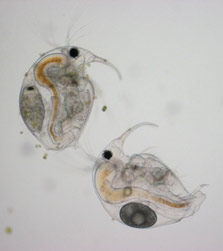
Nutrition
The Lepomis humilis fish depends mostly on insect larvae and crustaceans for their diet. For the most part these fish will eat anything including insects, aquatic insects, and zooplankton because they are considered Invertivore (Nature Serve Explorer, 2006). The definition of Invertivore “is a plant or animal which feeds on invertebrates” (Farmer’s Dictionary, 2010).
Scientists Hegrenes believed there to be a corresponding relationship between the diet of the Lepomis humilis, and the shape of the fish’s body shape and jaw. (Hegrenes 2001) To test Hegrenes hypothesis he took newly spawned orange-spotted sunfish and placed them into habitats that he could influence and control. Making this the control center for observing and gathering information to conclude his hypothesis. In each of the separate habitat’s these young sunfish were placed in, they were each given three different diets. Each of these diets was specific to the habitat that the fish was placed in. Hegrenes stated, “ According to a multivariate analysis of covariance on principal components derived from body truss, gill raker and pharyngeal jaw measurements, diet significantly affected morphology.” (2001) Which ultimately means that Hegrenes was able to conclude that his hypothesis of the shape difference between the mouths of Lepomis humilis was based upon their diets. In any instance this was a great find because now knowing how these fish adapt due to diets, they are able to infer a lot more about the Lepomis humilis’ surroundings. A scientist or a fish fanatic would be able to infer what type of organism the Orange spotted Sunfish was feeding on, then recognize from the organism what kind of habitat these fish live in.
There are many factors that can affect a sunfishes diet. A big factor that can cause a stir in the Orange spotted Sunfish is the habitat change. I myself am a fisherwoman and have witnessed many natural causes and human influences on fish’s habitat’s that have lead to a change in how they feed, and a change in where they are located. Scientists Timmermann, Dolan, and Chick wanted to see if a change in a river’s ecosystem had any affect on five different types of riverine fishes (Timmermann et al. 2011). Due to the change in the ecosystem and an attempt to improve the aquatic area for the animals, the three scientists believed it to be beneficial to look at the two separate units. The scientists were able to manage drawdowns in first pond, and the second was done naturally. The scientists noticed that the one unit with the natural drawdowns (reducing water amount) was the best place for these fish to feed at. The scientists watched these five different fish throughout a year to see the changes. This is a good example of how a fish’s habitat is a big influence on when it eats and how it eats. There are natural occurring events in the wilderness that fish and other animals are adapted to. When these fish were put in this situation they grew to learn and adapt their feeding habits.

